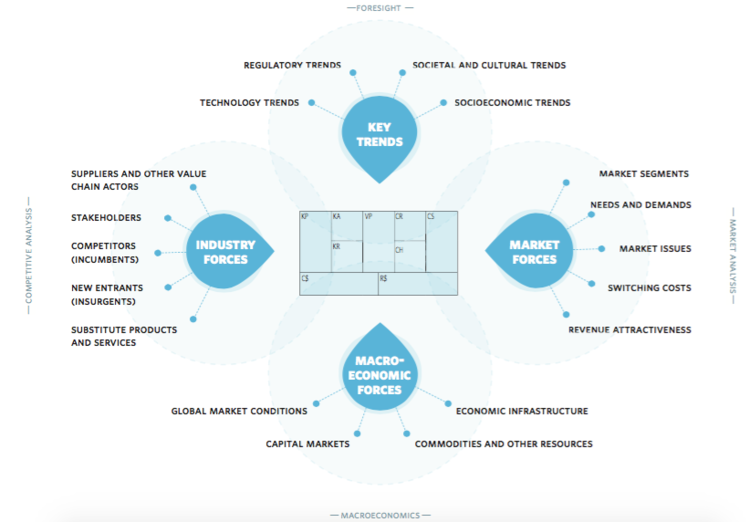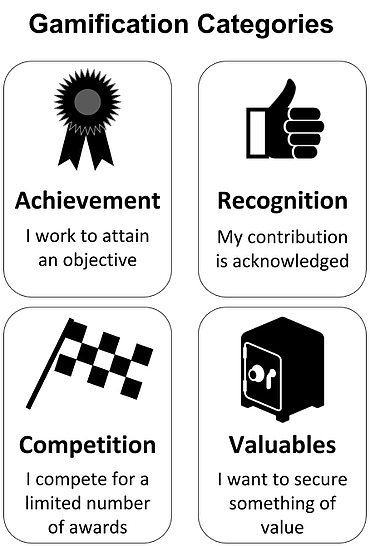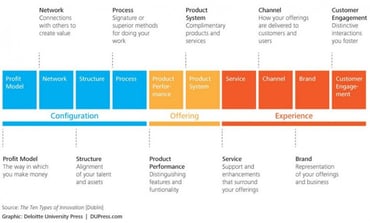The Lean Startup is a hot topic for organizations right now, so we asked a practitioner - Justin Souter, of Souter Consulting - to help readers get a handle on the elements of the Lean Startup framework, and provide some lessons from the field. The post is in four sections:
1. Where to begin with Startups and Corporate innovators
2. How to make effective decisions while 'in flight'
3. The Business Model Canvas – simple yet powerful
4. Business Model Innovation and visual business design
1. Where to begin with Startups and Corporate innovators
Let's look at how we can introduce the Lean Startup framework in a pair of day-long workshops.
Where to begin with Startups (and Intrapreneurs)
I typically deliver a pair of 9am to 5pm workshops, namely:
Day 1
The morning covers Lean Startup concepts and vocabulary, the tools involved, and the different mindset and use of ‘Customer Development’ as they apply to product and service development. Typically attendees are sceptical at first, however the use of introductory videos help convey key learnings.
The afternoon is when participants 'get out of the building' in teams to speak with real people – often in a shopping centre. The Lean Startup Machine’s Validation Board gives us a useful structure for these experiments, both in terms of preparation and also feedback:
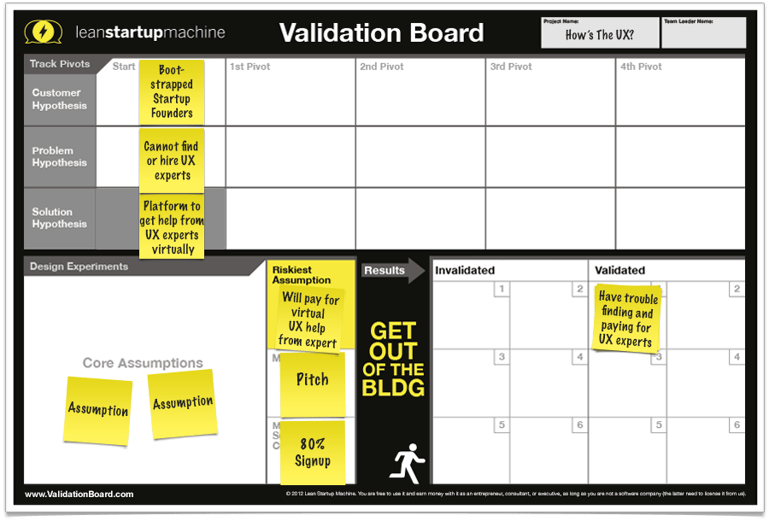
I have found this to be a crucial exercise to not only test the product & service ideas participants bring to the workshop, but they also discover that generally people are helpful, open to discussion, and that they learn lots as a result. It’s an essential rite of passage that visibly changes the body language of participants and their approach to their ideas and therefore entrepreneurship / innovation in general.
I’ve recently run a half-day workshop which covers the bulk of this material, and gives students the opportunity to plan their first series of experiments. Although videos are often better than ‘chalk and talk’, doing something practical with a Validation Board really helps bed in these initial learnings.
Day 2
Typically a minimum of a week between sessions is beneficial, so that:
- a) Day 1’s learnings have a chance to take root, and
- b) participants have a chance to experiment with ‘customer development’ back in their workplace / startup.
Often the first hour or so is a session to recap learnings and talk through reflections. I find that having the original Eric Ries videos available is useful for those who couldn’t make it to Day 1.
This came about because in one of my early classes, a Day 2-only participant said – at about 11.30 – “what, you mean it’s OK to set aside all that stuff we’ve been told we have to do?”. He’d listened to others talking about their experiences and had reverse-engineered that he was welcome to innovate and so had an “A-ha” moment!
I first learnt about The Lean Startup from Bobby our CEO at Happiest. I also learnt from Bobby about Roman Pichler and his (open source) Product Management Tools, which teams use to refine their ideas during the morning of Day 2. These seem to provide an excellent way for teams to bring together their thoughts to plug into the Business Model Canvas, which I’ll address further down in this post.
Learnings and the power of participation
My experience of running these workshops has shown that most people ‘get’ The Lean Startup, and leave energised and enthused about the possibilities.
You may witness participants start Day 1 by crossing their arms, legs, and tucking their chin in to their chest – which I read as being fairly ‘closed’. But frequently we’ll see this person ‘unwind’ and become an absolute natural in terms of customer interviews, using wallcharts, and generally asking “why don’t we do this all the time?”.
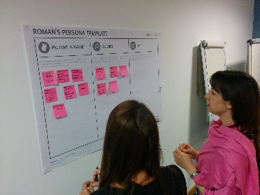 With these initial ideas, we can then use them as ‘opening gambits’ in interviews to help work on what problems (potential) customers want solved. You will know that folks are interested when the interviewee’s body language moves from being oblique to turning to face the interviewer and become more open and engaged.
With these initial ideas, we can then use them as ‘opening gambits’ in interviews to help work on what problems (potential) customers want solved. You will know that folks are interested when the interviewee’s body language moves from being oblique to turning to face the interviewer and become more open and engaged.
Customer interviewing is a skill to be learned, i.e. it is about being able to respond to things that occur that hadn’t been anticipated, to explore more deeply customer problems and needs – instead of stuff teams want to sell them.
Run experiments in how you do Lean Startup
If you get asked “are we doing this right”, a useful response is ‘the customer will tell you if you’re doing it right’! The goal of these initial sessions is to help students learn the process, and also learn how to conduct Customer Interviews by responding ‘in the moment’ to what reveals a promising line of questioning. Keep experimenting to find how this method can work for you.
Let's dive into how things fit together, so you can mix and match to suit.
2. How do we make effective decisions ‘in-flight’?
Startups have scarce resources – heck, we all do. Startups run out of cash, but intrapreneurs and innovators can run out of goodwill if they are unable to show results. I was recently told about an innovation team who were made redundant because they weren’t contributing to the bottom line. Perhaps short-sighted, but times are tough and business survival is paramount.
The challenge therefore is to understand progress, agree meaningful measures with the FD, and decide what to do next. This post suggests some ways of deciding what to prioritise.
Track Record
Over the last three years, I have worked with entrepreneurs and innovators to harness their ideas. Most recent examples:
- A Consultant Surgeon who wants to set up a global learning platform for the discipline in which he is an expert;
- A female founder who wishes to pivot from her existing business to establishing a new wellbeing event;
- A pair of co-founders who want to bring to market a lamp which speeds up recuperation from illness and injury; also applicable to social care, and prison environment;
- An online marketplace for property rentals.
By using the Business Model Canvas and Value Proposition Canvas, Founders and innovators start out by thinking about how to make money, and be open to the idea of pivoting their idea once a monetisable customer problem has been identified.
For example, I recently worked with a ‘Healthtech’ entrepreneur to bring a cleaning substance based on nanotechnology to market – could it be delivered as a service instead of a product?
Some more light-hearted ideas which have been put to the test in Customer Development exercise include:
- Sliced butter (think sliced cheese, and named ‘Butter by Far’); students are interested, but older couples definitely not – one glance from them made a lasting impact!;
- Off-beat funerals involving fireworks (called ‘Pyro-death-nics’); humans are interested, but pet-owners a strict no-no for sending their loved one into space, and;
- An ethical ISP (consumers aren’t interested); they care about price and speed – but consumers were non-plussed by an ethical differentiator.
The tremendous thing about these exercises is that in an hour, budding entrepreneurs were able to gather meaningful feedback – both positive and negative.
Frameworks for making decisions
Given the scarce resources of a startup, how can they (and early-stage innovators) make effective decisions which minimise waste, prioritise what needs to be done, and maximise the value-add?
In the Dot-com bubble, startups spent enormous sums to create first-mover advantage, but this assumed that they knew what customers wanted. The next section aims to provide high-level guidance to entrepreneurs on what activities to be doing at what stage, when developing an idea.
Product Adoption Curve and the three ‘Fits’
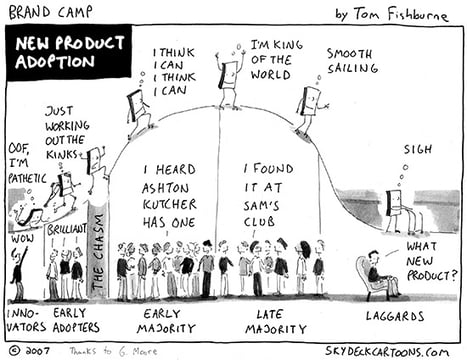 Source: https://marketoonist.com/2007/02/new-product-adoption.html
Source: https://marketoonist.com/2007/02/new-product-adoption.html
This fun cartoon by Tom Fishburne illustrates Geoffrey Moore’s product adoption curve and “chasm”, which frames the challenge faced by entrepreneurs. If the money is to be made with the early and late majorities, how can we get there?
The premise is that innovators and early adopters value even unpolished solutions because they address issues not presently solved – and can be willing to co-create a solution. This helps reduce market risk and product risk, because you’re making something that people want. This translates into a way to turn initial traction from “problem-solution fit” into “product-market fit” and therefore scale and profits and sustainability.
According to Strategyzer the following stages are important:
1. Problem-Solution Fit
- this occurs when you have evidence that customers care about certain jobs, pains, and gains. At this stage you've proved the existence of a problem and have designed a value proposition that addresses your customers' jobs, pains and gains. Unfortunately, you still do not have clear evidence that your customer really care enough about your value proposition enough to buy it.
2. Product-Market Fit
- occurs when you have evidence that your value proposition is actually creating value for customers by alleviating their pains and creating the gains they desire. Your product or service is beginning to gain traction in the market and you've gone through the long and iterative process of running tests that have validated and invalidated the various assumptions underlying your value proposition.
So, does your idea solve a customer problem? If not, can you leverage your idea to discover a problem that a customer will pay you for – and pivot to that? If so, is there a big enough market out there for you to build a business on the back of?
Is everyone on the bus?
As Tim highlighted in his post about the Lean Startup, Eric Ries defines a startup as a "human institution designed to create a new product or service under conditions of extreme uncertainty." The challenge for any intrapreneur is to get everyone else to realise the uncertainty when they are expecting you to execute against a hypothetical plan.
It could be that folk have politely nodded and said “we understand”, but have they made the emotional adjustment and understood the potential impact on their own plans and performance metrics which will ensue when you want to pivot? Do they ‘get it’?
3. The Business Model Canvas – simple yet powerful
Let's look at an effective way to convert product or service ideas into a coherent and sustainable business, and the use of the business model for competitive advantage.
Having observed many early-stage innovators through mentoring, startup weekends, and my own workshops, it seems that entrepreneurs are primarily focused on their product or service. However, how do we turn this product or service into a sustainable business (or social enterprise etc.)?
Business Model breakthrough
One of Steve Blank’s major breakthroughs has been to articulate the following:
Search Versus Execution
One of the things startups have lacked is a definition of who they were. For years we’ve treated startups like they are just smaller versions of a large company. However, we now know that a startup is a temporary organization designed to search for a repeatable and scalable business model. Within this definition, a startup can be a new venture or it can be a new division or business unit in an existing company.
If your business model is unknown – that is just a set of untested hypotheses - you are a startup searching for a repeatable business model. Once your business model (market, customers, features, channels, pricing, Get/Keep/Grow strategy, etc.) is known, you will be executing it. Search versus execution is what differentiates a new venture from an existing business unit.
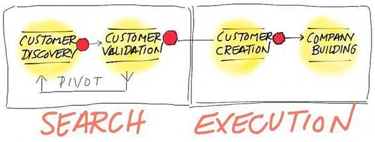
Strategy
The primary objective of a startup is to validate its business model hypotheses (and iterate and pivot until it does.) Then it moves into execution mode. It’s at this point the business needs an operating plan, financial forecasts and other well-understood management tools.
The diagram above illustrates Steve Blank’s “customer development” approach, which involves discovering customers who have a problem you can solve (problem-solution fit); validating there are enough of them who will pay you (product-market fit); pivoting if you can’t; and then if you’ve got product-market fit, scaling the business.
Business plans vs. Business Models
Alex Osterwalder created the Business Model Canvas (BMC) as “a strategic management and entrepreneurial tool that allows you to describe, design, challenge, invent, and pivot your business model.”
This Strategyzer video will hopefully aid with understanding:
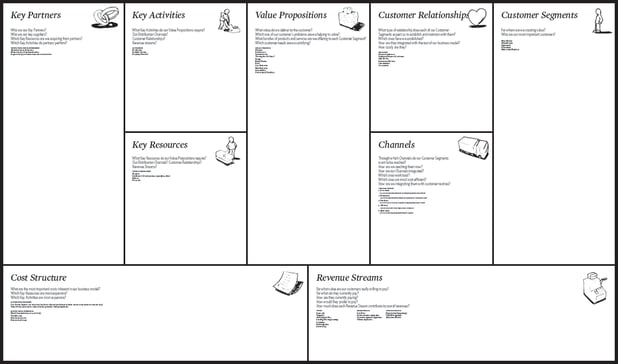 Source: https://strategyzer.com/canvas/business-model-canvas
Source: https://strategyzer.com/canvas/business-model-canvas
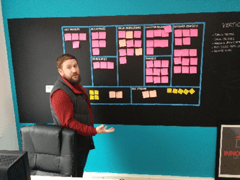 Having worked in a startup which assembled a detailed business plan based on 3-year projections, my belief is that many entrepreneurs are put in a really tough place when they’re asked to essentially make up usage numbers and resulting financial projections. We had early indications of problem-solution fit, but not product-fit market.
Having worked in a startup which assembled a detailed business plan based on 3-year projections, my belief is that many entrepreneurs are put in a really tough place when they’re asked to essentially make up usage numbers and resulting financial projections. We had early indications of problem-solution fit, but not product-fit market.
When so much is unknown, innovators are being asked to provide ‘execution’ metrics when they are still in ‘search’ mode – and then held accountable when these projections turn out to be (unsurprisingly) unreliable!
My hypothesis therefore, is that many good ideas die because they aren't measurable against a framework which doesn’t match the uncertainty of the search phase.
Business plans therefore are valuable if you’re launching something like a me-too washing powder, because you should be able to find out pretty much everything about that market. The Lean Startup, Business Model Canvas, and other tools provide a structure and rigour for the search phase which can be presented to business executives as a credible alternative to the execution approach at early stage.
Putting the BMC to good use
At the end of the second day of my workshops, teams put up their BMC on the wall, and use Post-It notes to fill out the canvas. My preference is to fill out the right-hand side of the canvas first, starting with Customer Segments, then moving on to Value Propositions – essentially following the running order set out in the video. However, in a coaching session recently the ‘coachee’ started with Key Partners. That seemed to work for him – different people have different working styles.
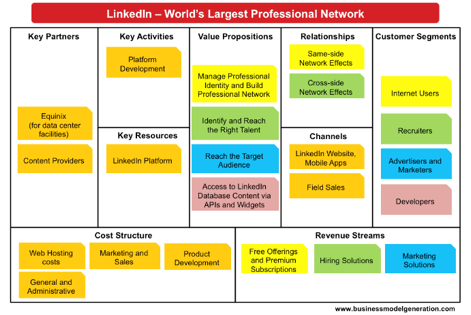
Each Post-It can then be treated as a hypothesis to test, in order to generate ‘validated learning’ as per Tim’s post. In the graphic above, you will notice that the colour of the Customer Segments follows across to Value Propositions, the Customer Relationships, and the Revenue Streams. This helps create individual narratives across the canvas: in this case, as with many others, the left side of the canvas tends to be similar across Customer Segments, hence the common orange theme.
In my experience, having teams stand up in front of the BMC is a powerful way to focus on the issues and keep emotions in check; working through the various building blocks in this experiential way helps participants take on the learnings ‘physically’, and is more effective even than putting the BMC on a table and working it through that way. Slightly mystical, but seemingly true!
Validate your assumptions
So, the BMC provides a framework for validating the underlying assumptions of the startup; by getting out of the building and gaining feedback, team members can return from customer interviews and move the Post-Its around based on real-life feedback. Team members can take photos of the different iterations of the BMC, or else there are online tools of varying sophistication. Over time therefore, a time-lapse record can be created of how the BMC has evolved.
Another advantage of the business model canvas over a business plan is that the customer conversations the team are having – and therefore the experiments it is running – can be used to prioritise startup activity. The founders are getting direct feedback all the time, and validating what works and what doesn’t – pivoting as necessary (each building block can be pivoted e.g. customer segment and / or channel).
4. Business Model Innovation and visual business design
In the final part of this post, we turn our attention to the related approaches and tools from the inventors of the Business Model Canvas.
Business Model Patterns
The book “Business Model Generation” outlines five different types of business model patterns (some of which will be familiar):
- Unbundling business model – the Internet and other communication technologies have meant that previous organisation structures can be revisited;
- Long tail model – inventories can include niche products which sell infrequently;
- Multi-sided platform model – Google search and Facebook are well known examples which bring together us (the product) with advertisers (the customer) in a very targeted way – essentially orchestrating a marketplace;
- Free as a business model – free to start using a service; more features, support etc. are charged for;
- Open business model – creating value by collaborating with outside partners.
There are many other patterns or derivations, described in books like Business Model Navigator and Business Model Factory. The advantage of sharing these insights is that founders and entrepreneurs can quickly understand how to translate the success they’re having in developing a solution and customer relationships, into how they’re going to make money. This helps reduce risk, and demonstrate to key stakeholders that the idea or project has a future.
Business Model Fit
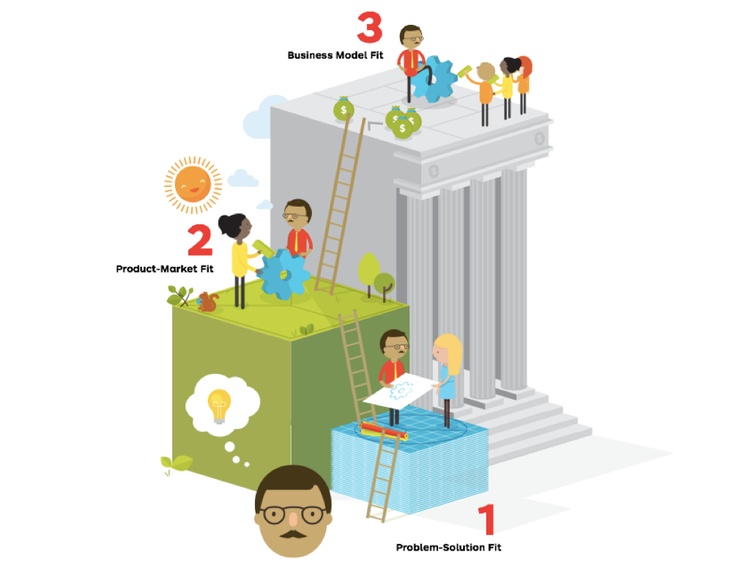 Source: http://blog.strategyzer.com/posts/2014/11/10/survival-of-the-fittest
Source: http://blog.strategyzer.com/posts/2014/11/10/survival-of-the-fittest
One of the key insights of Alex Osterwalder and colleages at Strategyzer has been the importance of “business model fit” i.e. you may have a great product, but can you actually make any money?
As Steve Blank’s quote above suggests, it’s a key objective of the startup to validate the different elements of the business model, and this is done by getting out of the building and talking to early adopters.
Strategyzer have usefully defined this as:
- Business Model Fit occurs when you have evidence that your value proposition is embedded in a profitable and scalable business model. You have done the laborious back and forth between designing a value proposition that creates value for your customers and a business model that creates value for your organization. You have found the right business model that delivers optimal profitability.
Value Proposition Design
In my experience of delivering these workshops, teams sometimes define value propositions as the ‘how’, and not necessarily the direct customer benefit. At times I have used the ‘Five Whys’ (as used in Lean Production Systems) to help lead the teams to the benefits.
Helpfully, the Strategyzer team have created a ‘plug in’ to the BMC called the “Value Proposition Canvas”:
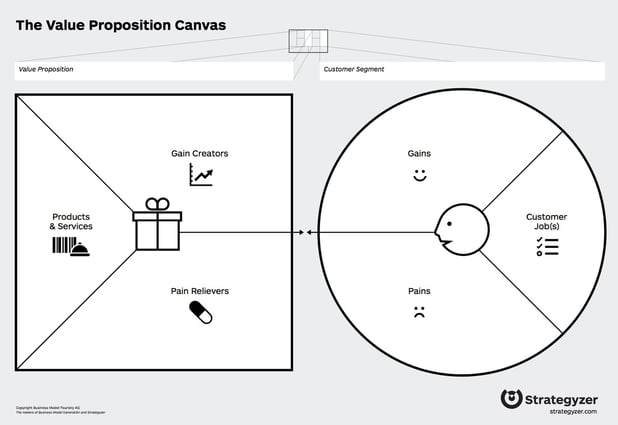 Source: https://strategyzer.com/canvas/value-proposition-canvas
Source: https://strategyzer.com/canvas/value-proposition-canvas
The Value Proposition Canvas helps you tackle a core challenge of every business — creating compelling products and services customers want to buy.
Again, this can be printed out to A0, put on the wall, and used for each BMC value prop to really get clear about what is being offered and why – defined in customer terms.
The wider environment, and potential uses for the BMC
For those readers who are fans of corporate strategy, you might be thinking that the BMC is very specific – but how can I position it in the wider context?
The Environment Map gives you prompts and questions about the Market Forces, Industry Forces, Key Trends, and Macro-Economic Forces. For me, this is another powerful way to conduct due diligence and bring different stakeholders together by talking through – and making real – what’s out there in the real world.
Strategyzer have helpfully blogged about 14 Ways to Apply the Business Model Canvas (e.g. for thinking about customers; for aligning the organisation; for investment decisions; for establishing the fit between organisations in mergers and acquisitions). The Mission Model Canvas has recently been developed for organisations which are less driven by making money – e.g. the US Defense and Intelligence community (Spring 2016), and the US State Department (Autumn 2016).
A powerful tool set
For me – having done an MBA, worked in a global IT company, and latterly in startups and in support of them – the work of Alex and the Strategyzer team has deep resonance and power to make explicit much which has not formerly been articulated clearly, and with a shared vocabulary.
By making business model conversations clearer, and creating insights around customer needs, this visual business design domain can cut through previous obfuscation and power politics to establish facts and lead to more value-add and better decision-making.
I also believe that the Lean Startup framework – including the work of Eric Ries, Steve Blank, Alex Osterwalder et al. is fast becoming a considerable and persuasive body of knowledge that has created many successful stories and case studies – e.g. Intuit, Farmgirl Flowers, Telefonica, MasterCard, Colgate, City of Hayward, Tesla, and many more.





